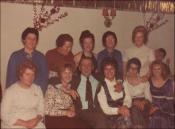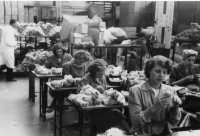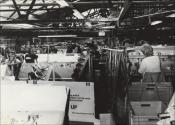Browse the interviews
Sorted by interviewee name
VSW047 Madge Sinclair, Mettoys, Fforestfach
Photos of Mettoys Factory, Forestfach, Swansea, 1960sNo transcript of the interview is available


VSE083 Violet Skillern, HG Stone Toy Factory, Pontypool
Violet describes her childhood in Pontypool and how her father had difficulty finding work after the war. In their row of cottages they shared a toilet but everyone was friendly. She started in the toy factory at 15 and describes being sent for 'glass washers' - teasing her. She describes moving from the stores to the sewing - finishing off the teddy bears and sewing on their eyes and embroidering their noses etc. 'Happy days' on the line. She did homework too. When she got married she left the factory. She talks of her pay. She recalls having to finish off a huge Teddy Bear destined for London. Mainly a female workforce and one of the designers was a woman. Annual dances. Everyone was a union member, but it was happy environment. The camaraderie was good. She walked to work but caught a bus home, and took her own lunch though there was a canteen in the factory. She didn't like it when a conveyor belt was introduced. They listened to the radio over a Tannoy. She remembers a holiday with fellow workers in Bournemouth. Not many social activities linked to factory.
VN023 Kathy Smith, Hotpoint, Llandudno
Kathy worked in the personnel dept. at Hotpoint from its beginnings in 1947 and, apart from a 15 year break when she looked after her family or worked on ships, including the Queen Elizabeth, she stayed until her voluntary redundancy in 1991, at the age of 62. She enjoyed working in the factory, knew everyone, and describes it as almost a family. She says it was a 'tremendous' place to work, although she admits she didn't have the monotony of the assembly line. In her job, there was something different every day and it was exciting. She never knew what she would be faced with next as people used to come to her with all sorts of problems. She did a variety of tasks under the role of personnel officer, including some time on the assembly line to try and understand how the workers could do such a repetive job day in day out.


VSE034 Shirley Smith, Burlington, Caerphilly;Burry Son & Company Ltd, Treforest
Shirley studied in a commercial college before leaving at 17. She worked in a shop before joining Burry’s in 1957 (until 1982) – a textile factory – she was a shorthand typist in the office. They had an ancient machine to calculate the men’s wages. She discusses her wages, and the one woman supervisor’s wages – equal to the men’s. It was very noisy on the factory floor and the workers were on their feet all day. Poor conditions in the office; very hot in the factory all year. She names the factories open on the Treforest Esate at this time. Her boss died suddenly and the factory was taken over by Burlington Gloves. She was made redundant in 1989.Part of this interview is available as an audio file
VSE042 Yvonne Smith, Polikoff's, Treorchy
Yvonne went to Commercial College after leaving school and began work at 17 (1959) in an accountant’s office. After a year she went to Polikoff’s as an assistant to the Personnel Officer. She started in 1960-1; they made men’s clothing. Her job was to check the clock cards. If late - explanation. Warning, then made redundant. Pressers, packing and cutters mostly men. Rest - c.1700 women. Women supervisors, male foremen – women couldn’t climb ladder. Difficulty of disciplining. Story of the nurses there. Describes factory – bedding department separate. 40 buses brought workers there and back and fore lunchtime. Huge canteen. Playing cards. Entertainment lunch hour. Xmas Eve – workers couldn’t collect pay packet until 4-5 o’clock. Social club in old vicarage. Talking and singing. She checked references and dismissed workers. She also went sick-visiting, e.g. to a Mental Hospital. Parcels of food for flood victims from the factory. 1961 small pox outbreak – immunisation in the factory. Also TB. No sick-pay for factory floor. Women paid less than men for same work. Personal problems e.g. body odours. Disputes over wages. Train trip to London. Nights out in Cardiff – Bill Hailey and the Comets. She left when pregnant 1964-5. Moved to Coventry and back to Neath. Clerk to police for 15-16 years. One manager was a randy old man. Lots of teasing both ways.VN047 Margaret Stanyer, Courtaulds, Flint
Margaret's first job after leaving school was at Courtaulds, on the rayon cake wrapping department. She just went for an interview and started straight away. She was only thirteen then, in 1940, as this was three weeks before her fourteenth birthday. From the cake wrapping, she moved on to the trolleys, which brought the cakes in for the girls and took them away again when they'd been covered. She had to be quick, she said, as the girls were on piece work and worked very fast. The cakes had to be handled carefully because if they were damaged, or knocked, they'd be rejects. Courtaulds workers were able to go on day release in the Flint Secondary Modern School, and Margaret took up dressmaking. They went for the whole day, instead of going to work. She thinks she earned about five pounds a week and there were frequent pay rises. As it was wartime, there wasn't a lot to buy with her wages, there were coupons for everything, so that's why she made her own clothes in the school. They used to have ENSAs in the dining room at lunch times but there was no music on the factory floor. They worked ten hour days. Margaret enjoyed the company there but in In 1946, when the restrictions changed so that people could leave the factory, she decided to join the Land Army, because she wanted to get out into the open air. She went to a farm in Tremeirchion for a month's training and stayed on there until 1949, although she could have chosen to go to other parts of the country.VN003 Yvonne Stevens, B.S.Bacon toy factory, Llanrwst;Dolgarrog Aluminium, Dolgarrog;Hotpoint, Llandudno;Danline, Llanrwst
Yvonne worked in Llanrwst toy factory on leaving school at 15, where she painted the wooden toys. She was one of the youngest and worked with two older women she called Aunty Lena and Aunty Martha. She liked the toys, which were well made out of wood, dolls houses and garages and farms, but could never afford to buy them. She enjoyed working there but wanted to earn more money, so she got a job at Dolgarrog Aluminium as an inspector. They made aluminium for lots of things from saucepans to corrugated roofs, and her job was checking for marks on the aluminium before it went to the packing dept. It was a very big factory, over a thousand workers, and she used to get the bus there from Llanrwst. She met her husband there and left the factory when her son was born two years after they married. She did cleaning jobs afterwards but never factory work again.VSE001 Rita Spinola (nee Stevens), Mr Spencer's leather factory, Cardiff;Horrock's, Cardiff
Rita left school at 15 (1954) and worked in a laundry while waiting for a vacancy at Horrock’s. First task – hand sewing; then machinist - making part of garment. They made lovely circular dresses and dressing gowns. Social life; radio and singing; Cutters and packers were women too. Factory closed c.1958/9. Attitude to factory work. Sales of other Horrock’s products too. Union – temperature at factory. Needle through finger. Lorna Leslie (singer - stage name Irene Spetti, David Dickinson’s wife) worked there. Moved to leather factory – 2/3 machinists making school satchels etc. Oiling machines – got impetigo, lack of hygiene and no facilities. No fun there. Stayed there 18 months and then went to Germany with her husband. She became pregnant. Returned and she worked in St Paul’s school as a dinner lady for 38 years.
